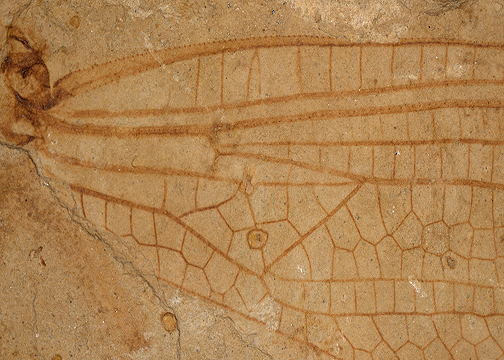Abstract
Rudiaeschna jarzembowskii sp. nov., the second species of the small aeshnopteran family Rudiaeschnidae, is described from the Lower Cretaceous Yixian Formation at the Liutiaogou locality, Ningcheng County, Inner Mongolia, NE China. The new species differs from the type species of the family, namely Rudiaeschna limnobia, in possessing less cells and crossveins in nearly all parts of forewing. It also shows a distally forked vein RP2, a character that was previously only known in taxa of the much more recent and derived aeshnopteran family Aeshnidae.
References
Bechly, G. (1996) Morphologische Untersuchungen am Flügelgeäder der rezenten Libellen und deren Stammgruppenvertreter (Insecta; Pterygota; Odonata), unter besonderer Berücksichtigung der Phylogenetischen Systematik und des Grundplanes der *Odonata. Petalura Special Volume, 2, 1–402. (Revised edition of the 1995 publication, with an English appendix including a new phylogenetic system of fossil and Recent Odonata).
Bechly, G. (2016) Phylogenetic systematics of Odonata— (homepage on Internet site: https://bechly.lima-city.de/phylosys.htm)
Bechly, G., Nel, A., Martínez-Delclòs, X., Jarzembowski, E.A., Coram, R., Martill, D., Fleck, G., Escuillié, F., Wisshak, M.M. & Maisch, M. (2001) A revision and phylogenetic study of Mesozoic Aeshnoptera, with description of several new families, genera and species (Insecta: Odonata: Anisoptera). Neue Paläontologische Abhandlungen, 4, 1–219.
Chang, M.M., Zhang, J.Y. & Miao, D.S. (2006) A lamprey from the Cretaceous Jehol biota of China. Nature, 441, 972–974. https://doi.org/10.1038/nature04730
Huang, D.Y. & Nel, A. (2010) Sinahemeroscopus magnificus, new genus and species of ‘libelluloid’ dragonfly from the Chinese Mesozoic (Odonata, Anisoptera: Nannogomphidae?). Zootaxa, 2388 (1), 44–48. https://doi.org/10.11646/zootaxa.2388.1.3
Jacquelin, L., Desutter-Grandcolas, L., Chintauan-Marquier, I., Boistel, R., Zheng, D., Prokop, J. & Nel, A. (2018) New insights on basivenal sclerites using 3D tools and homology of wing veins in Odonatoptera (Insecta). Scientific Reports, 8 (238), 1–7. https://doi.org/10.1038/s41598-017-18615-0
Li, Y., Nel, A., Ren, D. & Pang, H. (2011a) A new genus and species of hawker dragonfly of uncertain affinities from the Middle Jurassic of China (Odonata: Aeshnoptera). Zootaxa, 2927 (1), 57–62. https://doi.org/10.11646/zootaxa.2927.1.4
Li, Y., Nel, A., Ren, D., Zhang, B. & Pang, H. (2011b) A new Chinese Mesozoic dragonfly clarifies the relationships between Rudiaeschnidae and Cymatophlebiidae (Odonata: Aeshnoptera). Zootaxa, 2802 (1), 51–57. https://doi.org/10.11646/zootaxa.2802.1.5
Liu, Y.M. & Huang, D.Y. (2019) A large new nemestrinid fly from the Lower Cretaceous Yixian Formation at Liutiaogou, Ningcheng County, Inner Mongolia, NE China. Cretaceous Research, 96, 107–112. https://doi.org/10.1016/j.cretres.2018.11.018
Nel, A. & Huang D. (2009) First Chinese Cymatophlebiidae from the Middle Jurassic of Inner Mongolia (Odonata: Anisoptera: Aeshnoptera). Palaeodiversity, 2, 199–204.
Nel, A. & Huang, D.Y. (2010) A new Mesozoic Chinese genus of aeshnopteran dragonflies (Odonata: Anisoptera: Progobiaeschnidae). Comptes Rendus Palevol, 9: 141–145. https://doi.org/10.1016/j.crpv.2010.05.005
Nel, A. & Martínez-Delclòs, X. (1993) Nuevos Zygoptera y Anisoptera (Insecta, Odonata) en el Cretácico inferior de España. Estudios Geológico, 49, 351–359. https://doi.org/10.3989/egeol.93495-6362
Nel, A., Martínez-Delclòs, X., Paicheler, J-C. & Henrotay, M. (1993) Les ‘Anisozygoptera’ fossiles. Phylogénie et classification (Odonata). Martinia Numéro Hors-Série, 3, 1–311.
Ren, D. & Guo, Z.G. (1996) Three new genera and three new species of dragonflies from the Late Jurassic of Northeast China (Anisoptera: Aeshnidae, Gomphidae, Corduliidae). Entomologia Sinica, 3, 95–105.
Riek, E.F. & Kukalová-Peck, J. (1984) A new interpretation of dragonfly wing venation based upon Early Carboniferous fossils from Argentina (Insecta: Odonatoidea) and basic characters states in pterygote wings. Canadian Journal of Zoology, 62, 1150–1166. https://doi.org/10.1139/z84-166
Zheng, D.R, Nel, A., Chang, S.C., Wang, B. & Zhang, H.C. (2018) A new progobiaeshnid dragonfly (Odonata, Aeshnoptera) from the Lower Cretaceous of Liaoning Province, NE China. Cretaceous Research, 90, 1–6. https://doi.org/10.1016/j.cretres.2018.03.008


